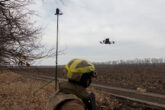November 17, 2021
The U.S. Military and the Coming Great-Power Challenge
For many of the last 30 years, the notion that the United States was locked in direct contest with other great powers seemed as outdated as the Cold War itself. Instead, successive U.S. administrations have pursued collective security on the assumption that the world’s great powers shared a common interest in preserving the existing international order.
By the late 2010s, however, it was increasingly clear that these efforts had failed. Russia seized the Crimea from Ukraine and supported its proxies in occupying parts of that country’s Donbas region. And despite reassurances to the contrary, China militarized the South China Sea islands. This was formalized in the 2017 National Security Strategy, and the challenge was given a full airing in the 2018 National Defense Strategy, which prioritized the growing challenge posed by a revanchist Russia and a rising China. Although it identified these threats to the international order, however, the NDS did not advance a robust new strategy to address them.
Simply put, China and Russia had no interest in joining a U.S.-led international order. They had long rejected it. They had only lacked the means to openly contest it.
Hence the growing recognition among U.S. policymakers that “great-power competition” had never ceased following the Cold War. This was formalized in the 2017 National Security Strategy, and the challenge was given a full airing in the 2018 National Defense Strategy, which prioritized the growing challenge posed by a revanchist Russia and a rising China. Although it identified these threats to the international order, however, the NDS did not advance a robust new strategy to address them.
This task has now been taken up by one of the NDS’s principal architects, Elbridge Colby, who served in the administration of President Donald Trump as a deputy assistant secretary of defense. In his book The Strategy of Denial: American Defense in an Age of Great Power Conflict, Colby provides a timely exposition of—and argument for—a new U.S. defense posture. Colby’s strategy focuses on the United States’ century-old objective of preventing a rival power from establishing hegemony on the Eurasian landmass. Colby accepts that the United States’ “unipolar moment” is over and warns that we now face a “new reality” in which Washington must accept that a war between great powers, “which once seemed a thing of the past...now seems considerably more plausible.”
Read the full article from Foreign Affairs.
More from CNAS
-
Defense / Transatlantic Security
When Defense Becomes Destruction: Austria-Hungary’s Mistake and Ukraine’s RiskThis article was originally posted on War on the Rocks. The southeastern Polish city of Przemyśl, with its elegant 19th century Habsburg-era train station, remains one of the ...
By Franz-Stefan Gady
-
Defense / Transatlantic Security
Ukraine’s Catch-22 MomentThis article was originally published in the Financial Times. In Joseph Heller’s wartime classic, Catch-22, the protagonist Yossarian seeks out the US army surgeon Doc Daneeka...
By Franz-Stefan Gady
-
CNAS Insights | Budgetary Own Goals Undermine “Speed and Volume”
On November 7, Secretary of Defense Pete Hegseth laid out a plan to overhaul the Department of Defense’s (DOD’s) acquisition system. Placing an emphasis on delivering new capa...
By Philip Sheers, Carlton Haelig & Stacie Pettyjohn
-
Drones: Who Is Making the New Weapons of War?
From Ukraine and Russia to Gaza and Sudan, drones have become a key weapon of war. Which companies are making them, and profiting from this rapidly expanding but controversial...
By Stacie Pettyjohn




